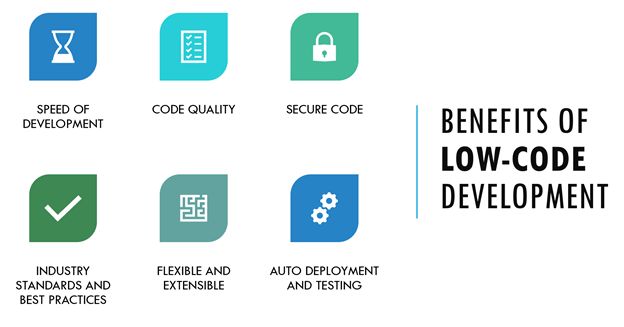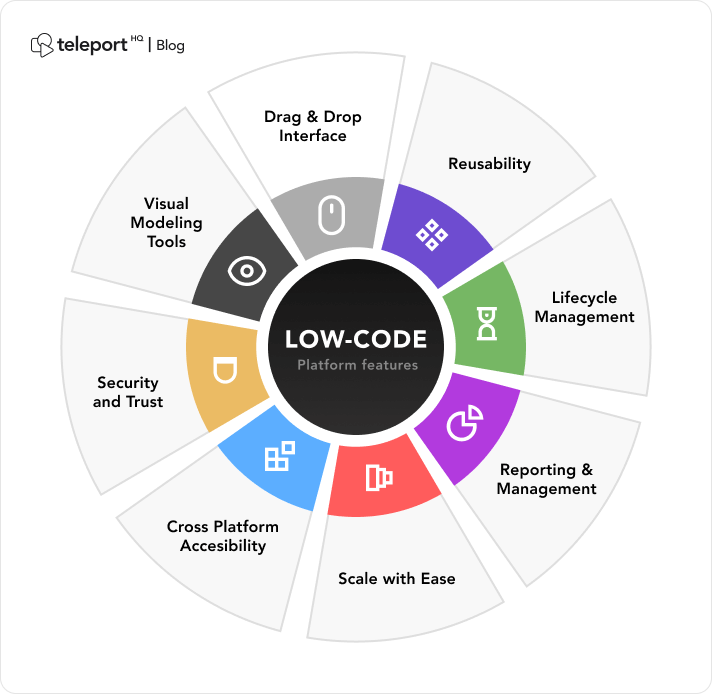Free Info For Choosing Low-code platforms for application development
Free Info For Choosing Low-code platforms for application development
Blog Article
Benefits Of Application Development With Low-Code In Terms Of Integration Capabilities
Low-code development is an excellent method of creating applications that are able to seamlessly integrate diverse systems and services. Here are key benefits from pre-built connectors, APIs and other tools:
Wide Range of Connectors Low-code platforms generally include a wide range of pre-built connectors to popular enterprise software (e.g., CRM, ERP databases, cloud services, etc.). This allows for easier integration with systems.
API Integration: Many low-code platforms have integrated APIs that are built-in that let developers easily connect with external data sources and services.
Easy To Use
Drag-and–Drop Integration Integrations can be created by using drag and drop interfaces. Developers and non-developers are able to achieve this without needing to write lengthy code.
Visual Workflow Creators: These visually appealing tools used to create workflows and data flow make it easier for users to comprehend the integration process.
Standardized Integration Methods:
SOAP and restful services: Supporting web-based services standard protocols such as REST and SOAP makes integration easy with a large variety of platforms and systems.
OData Standards and other Standards The support for standards, such as OData provides easy access to data and its manipulation across different platforms and apps.
Real-Time Data Synchronization:
Real-Time Integrations: Low-code devices allow real-time data synchronization between applications and systems, ensuring that the data is always current and consistent throughout the company.
Event-Driven Architecture: Certain platforms feature architectural designs driven by events which allow applications to react in real-time, to events which is essential for dynamic, interactive applications.
Legacy System Integration:
Low-code platforms are frequently employed to integrate systems from the past. This allows organizations to upgrade IT infrastructures without the need to completely overhaul the existing systems.
Data Migration Tools Data Migration Tools: Data migration tools built-in assist in the transfer of data from outdated systems to the latest applications developed using low-code platforms.
Integration of Third-Party Services:
Cloud Services: Integration with cloud services such as AWS Azure and Google Cloud allows easy deployment and scaling.
Integration of Business Applications Lowcode platforms can be used to integrate various business applications like Salesforce, SAP, Microsoft Dynamics etc. to create a seamless workflow that spans different functions of business.
Simplified Data Processing
Data models that are unifying: Some platforms that offer low-code support for unified models of data to make data management easier across systems.
Data Connectors Pre-configured data connectors make it easy to access and alter data from many sources.
Security and Compliance
Low-code platforms help ensure integrations comply with security protocols and standards, protecting data in the process of transport and in its rest.
Compliance Features: These platforms come with features that guarantee integrations meet regulatory requirements (e.g. GDPR, HIPAA), giving companies that handle sensitive information peace of mind.
Extensibility:
Custom Code and Scripts: Low-code platforms are often able to support more complex integrations, allowing for the addition of custom scripts and code. This allows flexibility without sacrificing ease of usage.
Plug-in Ecosystem An ecosystem of plugins and extensions that can extend integration capabilities through allowing users to easily create new features as needed.
The overall low-code platform's capabilities for integration make it a powerful instrument for creating interconnected applications that are scalable and efficient. These platforms streamline the process of integrating various IT systems, improve the flow of information, and assist companies adopt technologies that are already in use, while also leveraging new ones. Follow the top this site about Low-code Platform for application development for site advice including application modernisation, no code platforms, build a docker container, database in azure, azure sql, software for app development, develop web app, sso azure, develop web application, software for app development and more.
Advantages Of Low Code Application Development For Governance And Security
Low-code development of apps offers numerous benefits for security and governance. It is crucial to ensure that applications conform to regulations, are secure and are well managed throughout their lifetime. These are the primary advantages.
Unified management console: Low-code platforms usually provide a central administration console, where administrators manage all applications and ensure consistent governance within the company.
Role-Based Access Control RBAC: These platforms have robust controls based on role that allow administrators to establish access policies. This permits only authorized users to alter or access specific elements of a program.
Compliance and Regulatory Adherence
A lot of low-code platforms have built-in compliance functions. For instance, they are designed in accordance with the standards of the industry, regulations and laws (e.g. HIPAA, GDPR). They offer frameworks and tools that ensure applications meet the specifications.
Audit Trails and Logging Comprehensive logging and audit trails are usually integrated, allowing companies to track changes, monitor access and ensure compliance with internal and external laws.
Improve Security Measures
Data Encryption Low-code systems typically include built-in encryption of information in transit and in rest, securing sensitive data.
Security Certificates: Many low-code providers have a security certificates (e.g. ISO 27001 and SOC 2) which demonstrate their adherence to strict security guidelines. They offer an additional security level to their customers.
Automated security updates:
Regularly scheduled updates and patches Low-code platforms usually manage regular patches and security updates automatically, making sure that applications are protected against the latest threats without the intervention of developers.
Security Monitoring - Continuous monitoring of security is typically comprised. This provides real-time insights and alerts about possible security threats.
Data Governance
Data Access Policies: These systems enable organizations to define and enforce policies on data access, ensuring that data access is restricted only to those who have been granted access and is properly used.
Data Masking and Anonymization The tools built into the system to mask and anonymize data help secure sensitive information in testing and development environments.
Consistent Lifecycle Management of Applications:
Pipelines for Development and Delivery: Low-code platform often include integrated pipelines for development and delivery pipelines that include security checks. Security is assured throughout the lifecycle.
Version Control: An integrated version control system is used to manage changes, allowing any modifications made to an application to be tracked. If required they can be reversed and the integrity of the application ensured.
User Authentication, Authorization, and Authorization
Single Sign-On (SSO). Support for advanced authentication and single sign-on simplifies and enhances security.
Multi-Factor Authentication: Many platforms have built-in support of multi-factor authentication. This adds an extra layer of security for applications.
Monitoring of Policy Enforcement and Compliance:
Low-code platforms are usually already pre-defined with templates for policies to assist companies in implementing security and governance policies swiftly.
Compliance Monitoring Tool: These instruments provide continuous monitoring, reports and analysis of compliance status. It is simpler to detect potential problems and take appropriate action.
Integrate into existing security infrastructures:
Seamless Intergration: Low-code platforms are designed for seamless integration with security tools and equipment, like Identity Management Systems, SIEM Solutions (Security Information and Event Management), and Firewalls.
API Security: API integrated security makes sure that integrations with an external system are secure. Secure data and ensure application consistency.
Training and Best Practices
Guided best practices: Many platforms have guidelines and suggested practices for the development of secure applications. They help non-developers comply with security standards.
Certain lowcode companies offer resources and security training for users to learn how they can build and maintain a secure application.
Low-code development offers a number of governance and security benefits that help ensure that applications are created and managed in a efficient way, safe and in compliance. These platforms have the frameworks and tools necessary to protect sensitive information as well as enforce policies and ensure compliance with regulations while reducing managing and monitoring. See the most popular recommended site on Legacy application modernization with Low-code for site info including cross platform mobile development, multiplatform mobile app development, application development platforms, azure sql databases, mobile app development platforms, azure sql databases, software for app development, develop cross platform mobile app, application modernization, cross platform mobile dev and more.
Benefits Of Low-Code App Development With Respect To Limitations And Customization
Low-code development provides an unbiased approach to dealing with the limitations of the system, while also providing the possibility of customizing. These are the major advantages: Handling limitations
: .
Low-code platforms simplify development by providing pre-built templates and components. This allows for quicker deployment and the development of more complex applications.
Guided Workflows A lot of platforms provide wizards and workflows that guide developers through the complex process. This reduces the possibility of error, while ensuring consistency.
Scalability Solutions:
Scalability Built-In: Lowcode platforms usually include capabilities to support scalable architecture. They enable applications to handle growing loads without requiring major overhauls.
Performance Monitoring: tools for monitoring and optimizing performance are integrated in the application to ensure it's efficient regardless of how it expands.
Security and Compliance
Low-code platforms are equipped with security options, such as security access control based on role encryption, as well as automated checks for security compliance. These features address common concerns about security.
Regular Updates: Platforms frequently change their security protocols and compliance procedures. This makes sure that applications remain secure from new threats.
Customization:
Extensibility:
Low-code platforms allow custom code They allow the integration and the use of custom code.
Moduls and plugins that are custom-designed Developers are able to develop custom plug-ins and modules that have specific features that are tailored to the specific requirements of a particular business.
APIs and integration:
API Support: A full API support is available to enable seamless integration and connectivity with external systems.
Third-Party services: Low-code platforms provide connectors that are designed to work with popular third party services. This makes it easier to customize and integrate applications.
Flexible UX/UI:
Customizable Interfaces Developers are able to create and alter user interfaces based on specific usability and branding criteria which results in a custom user experience.
Responsive Design Built-in features of responsive design guarantee that apps can be adapted to different screens and devices.
Business Logic Customization
Visual Workflow Builders Visual tools for designing and customizing workflows and business logic allow developers to create complex, tailored processes with no extensive programming.
Conditional Logic and Scripting: Platforms permit the use of conditional logic and custom scripting to handle specific business rules and scenarios.
Data Management:
Custom Data Models: Developers have the option to create customized data models specifically for particular applications, and tailoring the handling of data to the specific requirements of business.
Advanced Data Processing: Integration with advanced tools and capabilities for data processing allows for customizing how data is analyzed and utilized within the application.
Balance Customization and Limitations:
Frameworks & Standards
Best Practices Compliance Low-code platforms facilitate adhering to industry best practices and standards, which helps in maintaining high-quality, flexible, and secure apps.
Governance Frameworks Integrated governance frameworks help to ensure that any modifications don't affect the integrity, conformity or security of the application.
Iterative Development and Feedback
Rapid prototyping: By being able to rapidly prototype and test customizations developers can improve upon the feedback of users to improve the functionality of the application.
Continuous Improvement: Low-code systems permit continuous improvement, allowing for continuous customization and improvement as the business needs change.
User Empowerment
Giving Citizen developers the tools they need: The low-code platform's intuitive interfaces allow non-developers modify the application. This boosts the number of contributors able to modify and improve applications.
Support and training: A lot of platforms include extensive training resources as well as support services to help users in making modifications that are effective without affecting the performance or stability.
In general, low-code development provides a solid system for dealing with limitations, and offers a wide range of possibilities for customization. This allows businesses to develop and maintain applications that are both tailored and efficient to meet their individual requirements while maintaining the highest standards of safety, quality, and scalability.